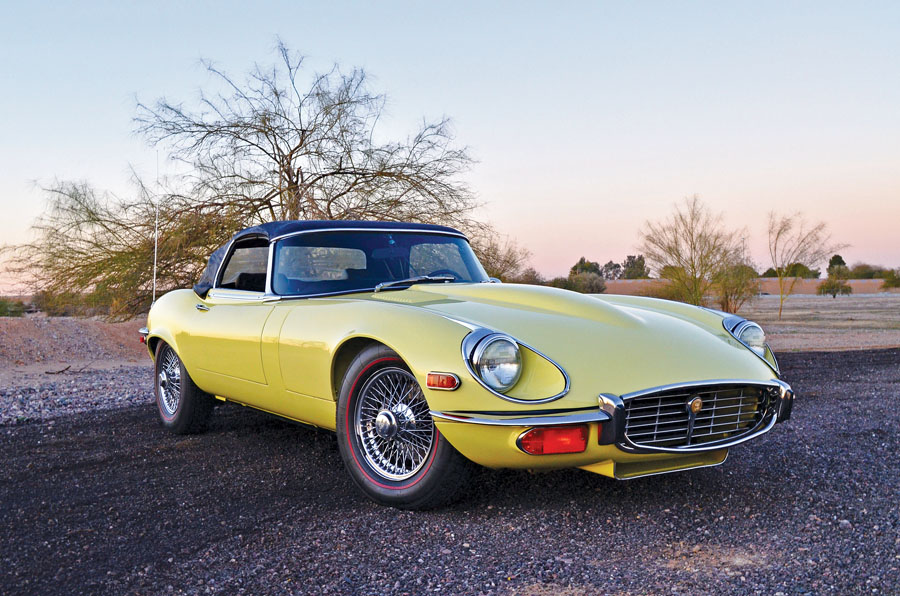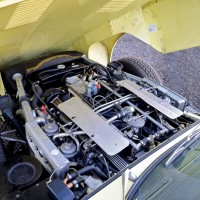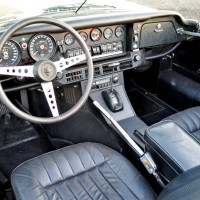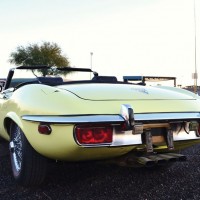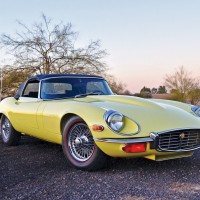SCM Analysis
Detailing
| Vehicle: | 1972 Jaguar E-Type Series III V12 Roadster |
| Years Produced: | 1971–74 (Series III convertibles) |
| Number Produced: | 7,990 |
| Original List Price: | $7,599 |
| SCM Valuation: | Median to date, $73,900; high sale, $170,534 |
| Tune Up Cost: | $650 |
| Chassis Number Location: | Plate on top of right footwell box under bonnet |
| Engine Number Location: | Stamped in vee between heads at rear |
| Club Info: | The E-Type Club |
| Website: | http://www.e-typeclub.com |
| Alternatives: | 1970–72 Aston Martin DBS V8, 1977–79 Ferrari 308 GTS, Jaguar E-type Series I or II |
| Investment Grade: | B |
This car, Lot 445, sold at no reserve for $64,900, including a 10% buyer’s premium, at Auctions America’s Fort Lauderdale, FL, sale on April 2, 2016. This was one of nine E-types on offer at this auction, and the cars ranged from Series I to III, with five being in the latter group.
Best described as a higher-level driver-quality car, this ride contained minor demerits commensurate with 55,865 miles showing. The catalog description mentions “a full body respray a few years ago with no rust found anywhere on the body,” and “a couple of small chips in the front and one small hairline crack in the passenger door edge.” There’s also a separated edge seam of the convertible top’s boot cover drooping down on the passenger’s side, lightly creased leather seating, and multiple scratches on the black air conditioner bottom edge above the factory radio. Such nits should have been tended to in pursuit of top dollars, but this situation is common with no-reserve offerings. The engine bay is clean, original and appears close to how it left Coventry.
In addition to standard power steering and brakes, our feature car also came equipped with optional factory air conditioning, chrome wire wheels, and an original AM/FM radio.
Since receiving a respray some time ago, the bodywork has picked up some stone chips, and the tea-tray air scoop under the nose may have been straightened after some light caresses from parking curbs. Redline tires set off the sparkly rims, and the boot lid is thankfully devoid of a chrome luggage rack. The overall vibe implies conservation and attentive enjoyment. The car appears ready for showing at club events.
Evolution from sports car to grand tourer
The original two-seat Series I E-type was the undisputed star when it was unveiled at the 1961 Earls Court Motor Show. The car offered a top speed of 150 mph, 0–60 mph in less than seven seconds, an independent rear suspension, four-wheel disc brakes, 265 horsepower and eye-popping body lines that led to the adjective “iconic” as a synonym for “E-type.” Period auto writers favorably compared the E-type to high-end European sports cars — and the car was less expensive than the competition from Italy.
Even in the United States, the list price was about a thousand big dollars more than the comparatively crude 1961 Corvette. For more background on Series I models, refer to my previous E-type profile on p. 64 of SCM’s June 2015 issue.
Over the years, the Series I and II E-Types (1961–71) received evolutionary updates. The most notable were increased engine displacement (from 3.8 liters to 4.2 liters), an in-house-built, all-synchromesh 4-speed manual and safety changes. Protruding toggle switches on the dash became flat versions, and twin Zenith-Stromberg carburetors replaced the three SU downdrafts (resulting in the loss of 20 horsepower) to comply with U.S. emissions requirements in 1968.
Also in 1968, Jaguar offered Series II 2+2 coupes with a slightly bulbous roofline, a taller and more curved windshield, a nine-inch wheelbase stretch to enhance interior volume, and a token rear seat that only suited tiny children.
Contrary to what you might expect, dealers found that the tin-top version was easier to sell than the roadster. The ever-increasing bulk of the American population may have had something to do with that!
Thus, the Series II 2+2 provided the blueprint for the Series III. Corporate patriarch Sir William Lyons’ cost-cutting mandated the continued use of 4.2-liter E-type bonnets. This challenged engineers to make the V12 fit in very limited space. So designers widened the hidden tubular front subframe by about four inches.
From 1971 to 1974, 7,990 convertibles and 7,297 coupes were produced — mostly for the American market.
The heart of the Series III is its 5.3-liter (326-ci) V12 of 60-degree design and three-plane crankshaft producing 250 horsepower at 6,000 rpm with 288 ft-lb of torque in U.S.-spec cars. The Series III car was 578 pounds heavier than the 1961 roadster, but the V12’s power delivery provided similar performance compared to the original heralded 6-cylinder engine.
Late Series I and II models offered automatic transmissions as an option, and the Series III cars — as found in our subject car — arrived with the proven Borg-Warner 3-speed automatic coupled to a 3.31:1 rear ratio.
Manual versus automatic
When an automatic transmission was first offered as an option, we Jag-nuts derided the sacrilege the factory inflicted on our performance sports car. That said, I still recall with utmost clarity when my wife selected manual first gear and tried to make a right turn uphill from a stop in my ’67 E-type. The resulting launch was a pure Don Garlits-on-a-dragstrip roar on a 90-degree heading. So, on reflection, perhaps the slush box in a Jag wasn’t such a bad idea for some drivers.
Today, top-tier sports cars are available only as automatics, as computers shift faster than humanoids, achieve faster acceleration, provide better fuel economy and emissions compliance — and protect you when you’re driving over your head.
While the computer-free Series III unit doesn’t offer such modern capabilities, it provides a measure of convenience in gridlock, and may help one escape the inconvenience of divorce.
Bidder interest in the Series III
So, was our feature car a good buy? The latest SCM Pocket Price Guide shows a median value of 1971–74 Series III convertibles at $73,900 with a high sale of $170,534. Based on those numbers, this sale falls on the positive side, as our subject car was $9,000 under median for a fairly well-bought result. But let’s look at competing cars at the same Auctions America auction, where the same bidders were making choices.
Lot 221 was a 1974 roadster with 27,408 miles. It is in Pale Primrose with a 4-speed manual and air conditioning. It is in comparable condition to our subject car. Lot 221 was a no-sale at $65,000.
Lot 414 was a 1973 roadster with 14,707 miles in Opalescent Silver Gray. It was a 4-speed manual, one-owner survivor, without air conditioning. This car sold post-block for $70,950.
Lot 557B was a 1973 roadster with 63,762 miles in British Racing Green. It was upgraded with a 5-speed manual and didn’t have air conditioning. It sold for $93,500.
Lot 798 was a 1973 coupe with 10,613 miles in Pale Primrose. It was equipped with an automatic transmission and air conditioning. It sold at no reserve at $31,900.
Paint and transmissions
These sale comparisons reveal two subtle trends, and I suspect they had to do with automatic transmissions and the paint color.
In the collectible E-type market, manual transmissions still rule, as we can see by the SCM Pocket Price Guide’s $3,000 deduction for automatics. Of the five Series III E-types on offer at Auctions America Fort Lauderdale, three had original 4-speed manuals (with one a no-sale), plus one was upgraded with 5-speed cogs. Our subject car and the coupe (Lot 798) were the only automatics.
Then there’s the color. Of the nine Series I through III cars on offer, four were wearing Primrose Yellow. One was a Series II roadster that was a no-sale (Lot 750), and among the three Series III offerings, one was a no-sale and two were let go at no reserve. Based on color alone, overall odds of selling were 50-50.
By coincidence, both of my E-types were Pale Primrose, and I admit it’s not a swooning color compared to Resale Red or British Racing Green. The flip side is that color changes turn off those in search of originality. I was tempted to go with BRG or Carmen Red, but I didn’t, as I believe that factory paint is a plus for future resale.
Satisfactory and astute outcomes
Our open-top feature car sold for $64,900, or $9,000 under SCM’s median value. Based on the numbers, this presentable investment was well bought, and it should prove to be an appreciating asset for the buyer. ♦
(Introductory description courtesy of Auctions America.)
